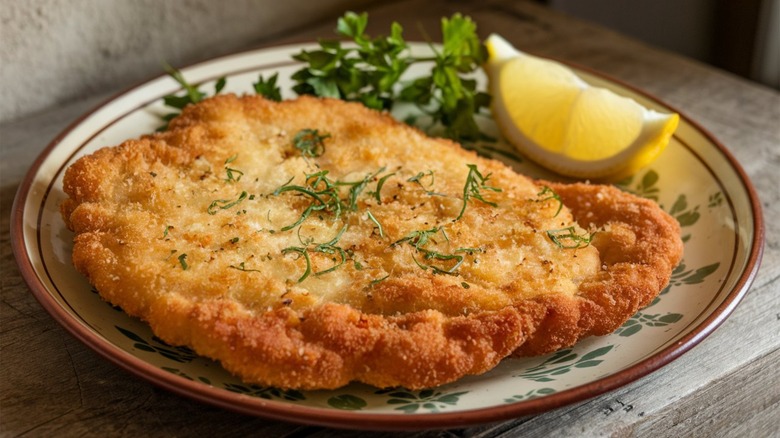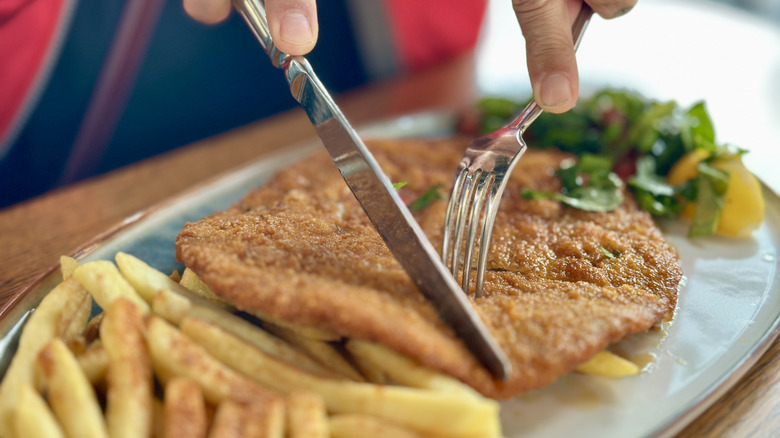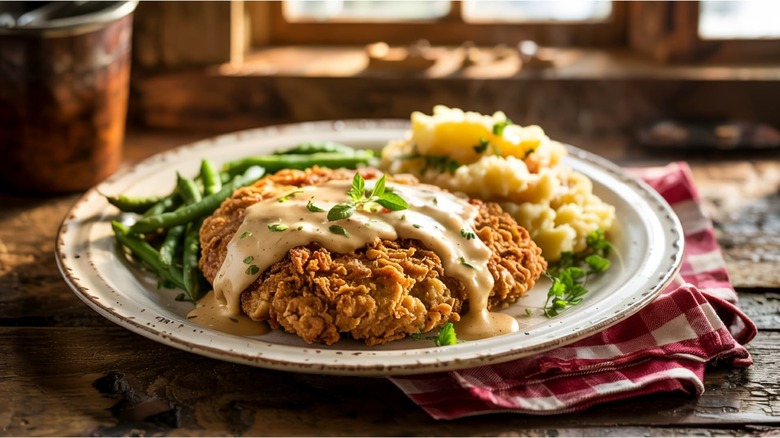Chicken-Fried Steak Vs Schnitzel: They're More Alike Than You Think
Recipes that call for pounding meat thin, breading it, and frying it are nothing new. From Japanese tonkatsu to Italian and Latin American Milanesa, it's an internationally popular way of transforming a less-than-stellar cut into something delicious. But the American staple chicken-fried steak and the German dish schnitzel are more similar than you might think — largely because one led to the creation of the other.
American cuisine has tons of German influence, and you can thank German immigrants for chicken-fried steak. The exact series of events is unclear, but it's believed that German immigrants in 19th-century Texas had a hard time finding veal for their favorite wienerschnitzel recipe. Other cuts of beef were easier to find, so adapting the recipe didn't require much effort. Combine this with the popularity of dredging meat in flour and salt before frying it in lard, and you get the modern American chicken-fried steak.
At the time, there weren't many ingenious ways to turn tough, cheap cuts of beef into something more palatable — especially methods that were so easy to do. Different preserving methods like corned beef with its coarse salt or trail jerky were fine options, but they couldn't deliver the hot, fresh meal people craved. However, while chicken-fried steak is a fairly cut-and-dry recipe, schnitzel is anything but. Ultimately, chicken-fried steak is a single dish, while schnitzel more commonly refers to a style of cooking.
Puffy breading helps distinguish schnitzel
Wienerschnitzel is more than just a fun phrase to say. Just like "chicken-fried" is an adjective describing a type of steak, schnitzel can be many things depending on the word that comes before it. Provided the meat's been pounded thin, seasoned, dredged, and fried, it can earn the name "schnitzel."
"Schnitzel" is German for "sliver" because the dish was commonly served sliced into strips for a table to share. Veal is the most traditional choice of meat, but you can use just about anything — pork and chicken are also common. Seasonings are typically simple, with salt and pepper on the meat and a basic egg wash and breadcrumb coating. This formed the basic concept that would later become chicken-fried steak, though Americans changed one major part of the recipe: the breading.
What really separates schnitzel from chicken-fried steak is the space between its meat and breading. Puff defines a superior schnitzel — the volume the breading attains when fried, which causes the two elements to separate. American frying standards, on the other hand, call for breading to adhere tightly to the meat rather than separate. This difference eventually led to the "chicken-fried" part of chicken-fried steak's name.
Fried chicken influenced chicken-fried steak's breading
Before schnitzel arrived in America, fried chicken was already well-established. Though every household may have had its own beloved recipe, fried chicken first appeared "officially" in "The Virginia Housewife," a cookbook from the 1820s. It eventually spread throughout the country, reinforcing the idea that the breading on fried foods should adhere firmly to the meat.
While German immigrants may have loved their puffy, delicate breadings, Americans saw some value in the recipe — provided they could adapt it to their tastes. Using less-loved cuts of beef like cube steak, chuck, and round, they put their own spin on things while keeping the practice of pounding these cuts flat. Like all American food, there's more flexibility in what counts as "chicken-fried steak," and the recipe isn't limited to specific meats, breadcrumbs, or whether it's battered, dredged, or coated. Provided it's thin, fried beef, you've got a chicken-fried steak.
At least according to most people. A big difference between schnitzel and chicken-fried steak is that the latter typically comes with gravy. But even that is up for debate — some insist that chicken-fried steak must be served with white gravy, while anything served with brown gravy is "country-fried steak." While that argument may never be settled, it's clear that schnitzel — and more specifically, wienerschnitzel — was the progenitor of the modern country-fried steak in origin, taste, and preparation.



